Frost may appear magical on a chilly morning—blanketing the landscape in delicate, shimmering crystals—but for gardeners, it often means heartbreak. One unexpected frost can blacken leaves, kill tender vegetables, and undo months of careful nurturing. But here’s the good news: frost damage can be prevented, minimized, and even repaired if you know the right strategies.
In this guide, we’ll explore why frost harms plants, how to protect your garden, and what to do if frost strikes unexpectedly.
🌱 1. Understanding the Science of Frost

To truly protect your garden, you must first understand what frost is and how it affects plants.
-
What is Frost?
Frost occurs when the temperature at ground level drops to 32°F (0°C) or lower. At this point, water vapor in the air freezes into crystals that coat leaves and stems. -
Why is Frost Harmful?
When ice forms on plant tissues, it punctures cell walls. This damages the plant’s internal structures, leading to wilted, blackened, or mushy leaves. -
Types of Frost:
-
Light Frost (29–32°F / -1–0°C): Only the most tender plants (like basil, beans, or cucumbers) are damaged.
-
Hard/Killing Frost (≤28°F / -2°C): Most annuals and warm-season vegetables die.
-
👉 Tip: Keep a soil thermometer handy, as ground-level temperatures can be colder than reported air temperatures.
🗓 2. Know Your Frost Dates

Every garden has a “frost calendar.” These first and last frost dates are essential for planning when to plant and when to protect.
-
First Frost Date (Fall): The approximate date when frost first appears.
-
Last Frost Date (Spring): The date after which it’s usually safe to plant frost-tender crops.
For example:
-
A gardener in Zone 5 may see the first frost in mid-October and the last frost in early May.
-
A gardener in Zone 9 might rarely experience frost at all.
👉 Check the USDA Plant Hardiness Zone Map or local weather services to know your garden’s frost patterns.
🪴 3. Plant the Right Crops for the Season
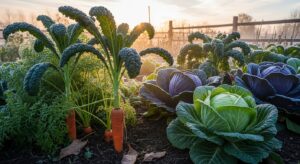
Choosing plants that match your climate can make or break your garden during frost season.
-
Cold-Hardy Crops (can survive frost):
Kale, spinach, cabbage, Brussels sprouts, garlic, carrots, leeks, onions. -
Moderately Hardy Crops (survive light frost):
Broccoli, peas, radishes, beets, and Swiss chard. -
Tender Crops (killed by frost):
Tomatoes, peppers, cucumbers, pumpkins, basil, beans.
👉 Pro Tip: Extend your season by planting frost-hardy vegetables in late summer to harvest through fall and early winter.
🛡 4. Use Protective Covers
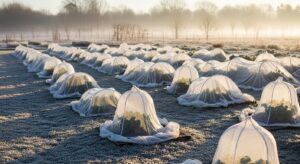
Covers are your first line of defense against frost damage. They trap heat from the soil, keeping plants warmer overnight.
-
Row Covers (Floating Fabric): Lightweight, breathable fabric placed over crops. Excellent for garden beds.
-
Frost Blankets/Sheets: Use old bed sheets, burlap, or tarps for emergency protection.
-
Plastic Covers: Create mini-greenhouses, but ensure ventilation during the day to prevent overheating.
-
Cloches: Glass jars, cut-off milk jugs, or plastic domes for individual plants.
👉 Remove covers each morning to allow sunlight in and prevent condensation buildup.
💧 5. Water Before a Frost

It might sound strange, but watering before a frost actually protects plants.
-
Moist soil retains heat better than dry soil.
-
Water acts as an insulator, slowly releasing warmth overnight.
-
Frost damage is often reduced when the soil is damp.
👉 Best practice: Water in the afternoon before a predicted frost. Avoid soaking leaves at night.
🌾 6. Mulch for Insulation
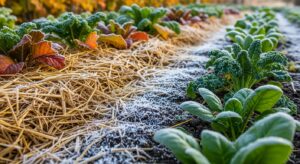
Mulch acts like a blanket, stabilizing soil temperatures and protecting roots.
-
Best Mulch Types: Straw, shredded leaves, pine needles, wood chips.
-
How to Apply: Spread 2–4 inches around the base of plants.
-
For Root Crops: Carrots, parsnips, and beets can even be left in the ground if mulched heavily.
👉 Bonus: Mulch also conserves water, suppresses weeds, and improves soil over time.
🌬 7. Take Advantage of Microclimates
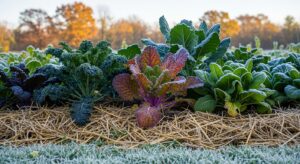
Your garden has warmer and cooler spots—use them to your advantage.
-
South-facing walls or stone paths absorb heat during the day and radiate it at night.
-
Fences and hedges provide wind protection, reducing frost risk.
-
Low areas in the yard collect cold air and are frost-prone—avoid planting tender crops there.
👉 Plant heat-loving vegetables near walls, patios, or raised beds where soil warms quickly.
🌞 8. Build Cold Frames and Mini Greenhouses

Cold frames and mini greenhouses are like season extenders.
-
Cold Frame: A wooden box with a clear lid (glass or plastic) that captures sunlight and warmth.
-
Mini Greenhouse: A simple plastic tunnel or small greenhouse that shields crops.
👉 Perfect for seedlings, salad greens, and herbs. They allow you to garden weeks earlier in spring and later into fall.
🐓 9. Animals in Frost Protection

If you keep backyard animals, they can play a role in frost survival.
-
Chickens warm their coops, which can be built near garden beds to radiate heat.
-
Ducks forage for slugs in cooler weather, reducing pests.
-
Bees, if overwintered properly, ensure pollination continues when spring returns.
While animals won’t eliminate frost risk, integrating them smartly contributes to a resilient ecosystem.
🍅 10. Harvest Before Frost
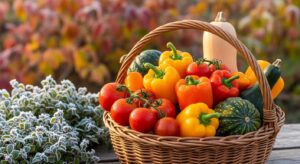
If frost is forecast, don’t wait—harvest tender crops.
-
Pick all tomatoes, even green ones (they’ll ripen indoors in paper bags).
-
Collect peppers, squash, and cucumbers before the cold sets in.
-
Root crops like carrots, beets, and turnips can often be stored in the ground with heavy mulch.
👉 Pro Tip: Herbs like basil blacken instantly in frost—harvest them early or preserve them by drying or freezing.
🌿 11. Recovering After Frost Damage
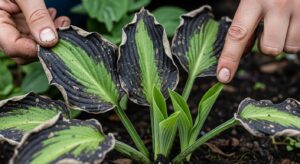
If frost has already struck, don’t despair—some plants can recover.
-
Do not prune immediately. Damaged leaves may protect the rest of the plant.
-
Water the soil to ease stress and promote regrowth.
-
Wait and observe. Perennials and hardy crops may bounce back within days if the roots survive.
-
Prune dead foliage later to encourage healthy new growth.
👉 Example: Kale and spinach often survive frost and taste sweeter afterward.
🔄 12. Long-Term Frost Planning
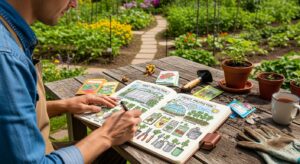
Resilient gardening is about planning for frost year after year.
-
Record frost dates and which plants survived.
-
Invest in durable frost covers or greenhouse structures.
-
Plant perennials that naturally withstand cold conditions.
-
Rotate crops so tender plants aren’t always at risk.
👉 Each season makes you a smarter gardener. Documenting your frost survival strategies ensures greater success in the future.
🌟 Final Thoughts
Frost may be one of gardening’s biggest challenges, but it doesn’t need to wipe out your hard work. By combining protection methods (covers, mulching, cold frames), smart crop choices, and recovery strategies, you can outsmart frost and keep your garden thriving.
When frost kills, it’s not the end; it’s a lesson in resilience. And with the right strategies, your garden will survive and thrive season after season. 🌱❄️
🔹 10 FAQs on When Frost Kills: Strategies for Garden Survival
1. What temperature is considered a killing frost for most garden plants?
A killing frost usually occurs at or below 28°F (-2°C), which damages or kills most tender annuals and warm-season vegetables.
2. How can I know when frost is likely to happen?
Check local weather forecasts, use frost alerts on gardening apps, or track historical frost dates for your zone. Cloudless nights with little wind are most prone to frost.
3. Which vegetables are most frost-tolerant?
Kale, spinach, cabbage, Brussels sprouts, garlic, carrots, leeks, and onions are among the most frost-hardy vegetables.
4. Do frost covers need to touch the plants?
No—frost covers should drape over supports or stakes to avoid touching leaves directly, as contact can still allow frost damage.
5. Is watering before a frost really effective?
Yes. Moist soil retains heat better than dry soil, releasing warmth overnight and protecting roots and lower leaves from frost damage.
6. How thick should mulch be to protect plants from frost?
Apply 2–4 inches of mulch around plant bases. For root crops, apply even thicker mulch layers to allow them to overwinter in the soil.
7. What is the difference between a cold frame and a greenhouse?
A cold frame is a small, low structure (like a wooden box with a glass lid) for protecting specific crops, while a greenhouse is a larger enclosed space for year-round growing.
8. Can frost-damaged plants recover?
Yes. Don’t prune right away; wait to see if new growth emerges. Perennials and hardy vegetables often bounce back if roots are unharmed.
9. What should I harvest first before a frost?
Tender crops like tomatoes, peppers, cucumbers, beans, squash, and basil should be picked before frost sets in, as they won’t survive.
10. How can I plan long-term for frost survival?
Keep a garden journal with frost dates, invest in durable frost protection tools, and choose hardy perennials and cold-tolerant vegetables for a resilient garden.